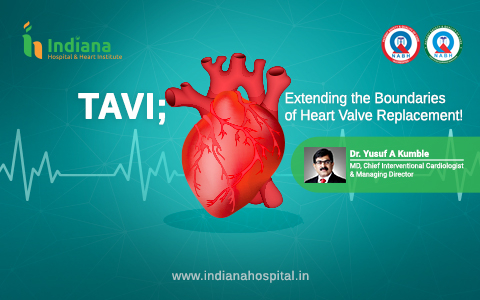TAVI – A paradigm shift in the management of aortic valve stenosis
TAVI – A paradigm shift in the management of aortic valve stenosis
Aortic Stenosis is the most common valvular heart disease wherein the narrowing of the aortic valve affects the supply of blood from the heart to the rest of the body, and it manifest itself usually at an elderly age. In India, the common causes of Aortic Stenosis are Rheumatic, Congenital and Degenerative problems. The commonest cause in the case of those above sixty is degeneration of the native bicuspid or the tricuspid valve. Its symptoms include a wide range of problems such as breathlessness (dyspnoea), chest pain (angina) and loss of consciousness (syncope). The only treatment available for Aortic Stenosis is either surgical replacement or TAVI/TAVR (Transcatheter Aortic Valve Implant – Similar to Angioplasty).

In AVR (a traditional surgical aortic valve replacement), either a metallic valve or a tissue valve is used. This technique emerged in the 1960s, and is one of the most accepted treatment modalities in the world. The metallic valve is the most commonly used prosthetic valve. However, it needs life-long oral anti coagulation, something which needs close supervision by monitoring the prothrombin time (PT/INR). If INR exceeds the therapeutic range that will cause major bleeding, and if it is less than the therapeutic range, the valve will be thrombosed. So, keeping INR within the therapeutic range is of paramount importance in maintaining the metallic valve. Although the bio prosthetic valve does not require oral anti-coagulation, it can degenerate over a period of 10-15 years. So, it is usually used only in the case of elderly people.
Balloon aortic valvuloplasty has emerged as a treatment of choice for aortic stenosis in congenital and rheumatic aortic stenosis. However, this cannot be done in degenerative aortic valve stenosis in elderly patients.
In TAVI, bioprosthetic valve (tissue valve) is used. It is usually done on elderly people. In 2002, the first TAVI/TAVR (Transcatheter Aortic Valve Replacement) was done through the transvenous approach. Later, TAVI was performed through the transapical and transaortic approach. The thorax is opened with the help of a surgeon and then the cardiologist would complete the procedure.
Non-surgical micro-invasive procedure
In 2009, the first transfemoral arterial approach, TAVI, was carried out. It is presently emerging as a non-surgical micro-invasive procedure. In this procedure, a small key hole opening measuring about 3cms is made in the inguinal region – femoral artery is catheterised by using 14F or 16F catheter through which a self-expandable valve is transported and fixed at the aortic valve area. It can also be done using a balloon mounted valve. In this procedure, we do not require any surgical help or any incision. The patient need not be under general anaesthesia; a mild sedation may however be given. The procedure takes from 1 to 2 hours. The patient does not need to be admitted in the ICU and can be discharged within 2 to 3 days. Other advantages include no blood being required and the patient being able to get back to work within a week. This procedure is costly compared to the standard surgical procedure. Moreover, this is a bio prosthetic valve and it may degenerate over a period of time. However, this valve can be replaced by repeating the TAVI procedure at a later date.
This procedure is not recommended routinely for all Aortic Stenosis patients. Firstly, the patient has to be screened by CT angiogram followed by aortogram. If the anatomy is feasible only then the patient will be recommended to undergo TAVI. If the CT angiogram shows low coronaries, the patient may not be a suitable candidate for the procedure.
Another important aspect of this procedure is femoral access. If the femoral artery is tortuous or calcified, then procedure could be difficult. If there is adequate diameter only then can the long catheter be introduced into the femoral artery. The procedure is commonly carried out in high risk individuals with other co-morbidities for anaesthesia and surgery.
TAVI is a new boom in the field of cardiology, and it will be available in most of the centres at an affordable cost in the future. Indiana Hospital and Heart Institute, Mangalore was the first to perform TAVI procedure in coastal Karnataka.
By Dr. Yusuf A. Kumble
MBBS, MD, DM (Cardio – AIIMS), (DNB Cardio), FSCAI, FESC, FACC (USA)
Chief Interventional Cardiologist and Managing Director, Indiana
Hospital & Heart Institute Ltd., Mangaluru
